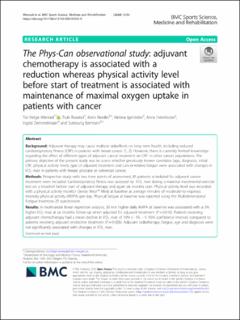| dc.contributor.author | Wiestad, Tor Helge | |
| dc.contributor.author | Raastad, Truls | |
| dc.contributor.author | Nordin, Karin | |
| dc.contributor.author | Igelström, Helena | |
| dc.contributor.author | Henriksson, Anna | |
| dc.contributor.author | Demmelmaier, Ingrid | |
| dc.contributor.author | Berntsen, Sveinung | |
| dc.date.accessioned | 2021-02-10T10:07:44Z | |
| dc.date.available | 2021-02-10T10:07:44Z | |
| dc.date.created | 2020-11-11T11:38:28Z | |
| dc.date.issued | 2020 | |
| dc.identifier.citation | BMC sports science, medicine and rehabilitation. 2020, 12(2020), Artikkel 53. | en_US |
| dc.identifier.issn | 2052-1847 | |
| dc.identifier.uri | https://hdl.handle.net/11250/2727126 | |
| dc.description | This article is licensed under a Creative Commons Attribution 4.0 International License, which permits use, sharing, adaptation, distribution and reproduction in any medium or format, as long as you give appropriate credit to the original author(s) and the source, provide a link to the Creative Commons licence, and indicate if changes were made. The images or other third party material in this article are included in the article's Creative Commons licence, unless indicated otherwise in a credit line to the material. If material is not included in the article's Creative Commons licence and your intended use is not permitted by statutory regulation or exceeds the permitted use, you will need to obtain permission directly from the copyright holder. To view a copy of this licence, visit http://creativecommons.org/licenses/by/4.0/. The Creative Commons Public Domain Dedication waiver (http://creativecommons.org/publicdomain/zero/1.0/) applies to the data made available in this article, unless otherwise stated in a credit line to the data. | en_US |
| dc.description.abstract | Background: Adjuvant therapy may cause multiple sideeffects on long term health, including reduced cardiorespiratory fitness (CRF) in patients with breast cancer (1, 2). However, there is currently limited knowledge regarding the effect of different types of adjuvant cancer treatment on CRF in other cancer populations. The primary objective of the present study was to assess whether previously known correlates (age, diagnosis, initial CRF, physical activity level), type of adjuvant treatment and cancer-related fatigue were associated with changes in V˙O2max in patients with breast, prostate or colorectal cancer. Methods: Prospective study with two time points of assessment, 85 patients scheduled for adjuvant cancer treatment were included. Cardiorespiratory fitness was assessed by V˙O2max during a maximal incremental exercise test on a treadmill before start of adjuvant therapy and again six months later. Physical activity level was recorded with a physical activity monitor (Sense Wear™ Mini) at baseline as average minutes of moderate-to-vigorous intensity physical activity (MVPA) per day. Physical fatigue at baseline was reported using the Multidimensional Fatigue Inventory-20 questionaire. Results: In multivariate linear regression analysis, 30 min higher daily MVPA at baseline was associated with a 5% higher V˙O2max at six months follow up when adjusted for adjuvant treatment (P = 0.010). Patients receiving adjuvant chemotherapy had a mean decline in V˙O2max of 10% (− 19, − 1; 95% confidence interval) compared to patients receiving adjuvant endocrine treatment (P = 0.028). Adjuvant radiotherapy, fatigue, age and diagnosis were not significantly associated with changes in V˙O2max. Conclusion: The results of the present study indicate that adjuvant chemotherapy is associated with a subsequent reduction in V˙O2max in patients with cancer whereas MVPA before start of adjuvant treatment is positively associated with a higher V˙O2max after end of adjuvant treatment. | en_US |
| dc.language.iso | eng | en_US |
| dc.subject | cardiopulmonary exercise testing | en_US |
| dc.subject | physical activity | en_US |
| dc.subject | oncological treatment | en_US |
| dc.subject | cancer related fatigue | en_US |
| dc.title | The Phys-Can observational study: adjuvant chemotherapy is associated with a reduction whereas physical activity level before start of treatment is associated with maintenance of maximal oxygen uptake in patients with cancer | en_US |
| dc.type | Peer reviewed | en_US |
| dc.type | Journal article | en_US |
| dc.description.version | publishedVersion | en_US |
| dc.rights.holder | © The Author(s). 2020. | en_US |
| dc.source.pagenumber | 10 | en_US |
| dc.source.volume | 12 | en_US |
| dc.source.journal | BMC sports science, medicine and rehabilitation | en_US |
| dc.identifier.doi | 10.1186/s13102-020-00205-9 | |
| dc.identifier.cristin | 1846883 | |
| dc.description.localcode | Institutt for fysisk prestasjonsevne / Department of Physical Performance | en_US |
| cristin.ispublished | true | |
| cristin.fulltext | original | |
| cristin.qualitycode | 1 | |
